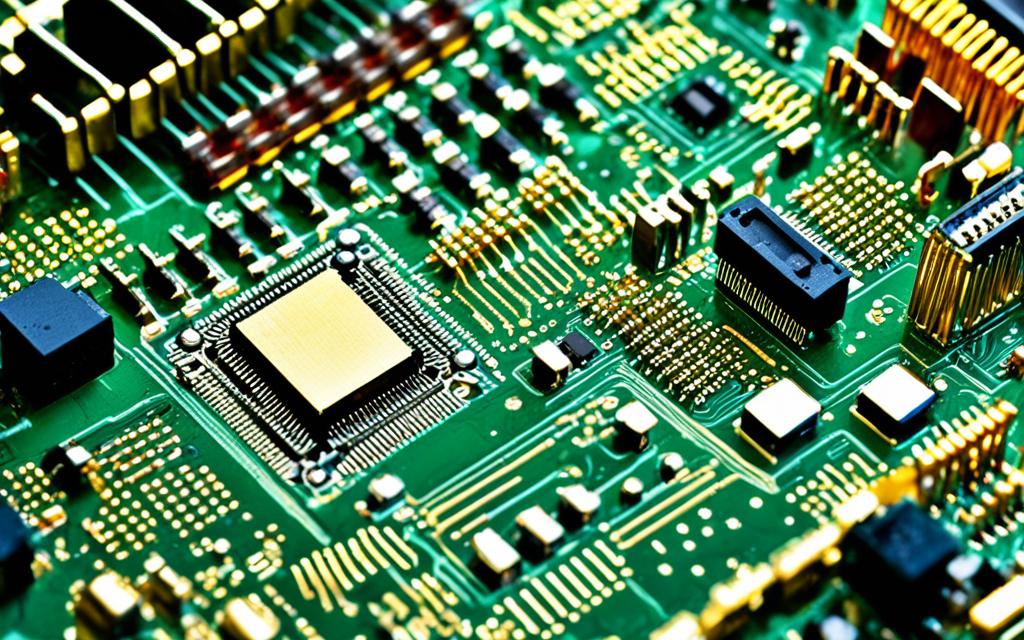Did you know your old computer might be worth more than you think? Computers and electronic devices are filled with valuable metals. This includes gold, silver, and palladium. Among computer parts, motherboards, printed circuit boards, CPUs, RAM chips, internal modems, and other peripherals are rich in gold. The average old computer has about 1/5th of a gram or $12 worth of gold1. This value changes based on the e-waste type. Recycling e-waste is profitable, especially in large amounts.
Key Takeaways:
- Computers and electronic devices contain valuable metals, including gold, silver, and palladium.
- Old computers can contain about 1/5th of a gram or $12 worth of gold on average1.
- The value of gold in a computer will depend on the type of e-waste being considered.
- Recycling e-waste can be a profitable endeavor, especially with large quantities.
The Importance of Gold in Electronics
Gold is key in electronics, prized for its superb conductive properties and resistance to corrosion. It greatly benefits devices like phones, calculators, GPS units, and computers. This metal’s good conductivity makes sure data is transmitted quickly.
It’s also used in electrical connectors, switches, and relays. This ensures devices are durable and reliable even under tough conditions.
Gold is crucial in aerospace and defense too. It helps electronics endure extreme temperatures, vibrations, and other harsh environments.
Gold is especially important in computer motherboards. It is found on their surfaces and connectors2. A single laptop might have quite a bit of gold, worth between $15 to $25. This contributes to the vast 50 million tons of e-waste we see worldwide annually2.
The use of gold in chips has dropped since 1998. This is when solid gold wiring was slowly removed from IC packaging2. Even with reduced gold use, mining remains profitable. It is expected to stay that way till 2050, with new discoveries likely to push this further2.
Efforts to recycle gold from e-waste are increasing. Gold recovery from old electronics is efficient through recycling2. But, extracting gold on your own can be risky due to the dangerous materials needed.
In semiconductor design, gold’s necessity is carefully considered. It’s used only when needed for conductivity and device lifespan. This careful use of gold helps in maintaining device quality and resource efficiency2.
The move to gold plating in electronics has reduced the amount of gold in devices. This means less gold is available for recovery from modern devices compared to older ones. Plated gold is efficient, yet still maintains high device quality2.
Gold Content in Different Electronic Devices
| Device | Gold Content (ounces) |
|---|---|
| Smartphones | 0.03 to 0.05 |
| Computers | 0.1 to 0.15 |
| Televisions | 0.2 to 0.3 |
| Other Consumer Electronics | 0.01 to 0.05 |
| Motherboards | 0.2 to 0.5 grams |
| Cell Phones | 0.001 to 0.02 grams |
This table shows how much gold is in various devices. For example, one ton of computer parts has more gold than 17 tons of gold ore3. The gold’s value can change depending on its purity, quality, and market demand. Companies upgrade their IT gear often turn to certified IT asset disposition (ITAD) services. They recover precious metals’ value while protecting data and the environment4.
Extracting Gold from Computers
Getting gold out of computers is careful work. It involves handling dangerous chemicals and using special gear. But, if you’ve got the know-how and tools, it can make you money.
“Gold from old computers can be taken out in different ways. These include gold plated parts, pins, and even solid gold bits”5.
Start by taking the computer apart. Look for parts like circuit boards and connectors that have gold.
Gold recovery steps such as cupellation can boost gold purity to about 95%5. This process melts down the material, removing impurities and leaving behind pure gold and silver.
The conversion rates for gold are as follows: 1 troy oz = 480 grains, 1 regular oz = 437.5 grains5.
“Through cupellation, low-grade gold parts become 75.9 grains of high-grade gold from 180 grains”5.
The Borax Method is another gold extraction technique. It lowers gold’s melting point. This way, gold is recovered safely, without harmful by-products5.
Small amounts of gold flakes and dust can also be gathered. They are precious, adding to the gold extraction profit5.
The gold you get can be quite valuable. It’s worth between £600 and £1600 for three months of work5.
| Estimated Value | Weight | |
|---|---|---|
| Gold from an average computer | Over $10 | 1/5th of a gram6 |
| Gold from an average laptop | Over $6 | About 1/10th of a gram6 |
| Gold from a smartphone | Approximately $2 | 0.034 grams6 |
While this task can be profitable, safety should always come first. Using chemicals needs caution. Wear protective gear and ensure your space is well-ventilated7.
The whole gold extraction from computers usually finishes in a few days7..
“Wrongly getting rid of the used chemicals can harm health and the planet. It’s vital to throw them away correctly to avoid trouble”7.
Recycling gold from computers is not just profitable. It also helps the environment by reducing e-waste. With the right approach, turning old computers into gold can be fruitful.
Conclusion
Old computers have gold and other valuable metals inside. A graphics card has about 0.5 to 1 gram of gold8. The gold in a graphics card may seem small compared to its total cost8.
The gold improves the graphics card’s performance8. Yet, taking gold out of graphics cards costs more than it’s worth8.
It’s vital to properly dispose of and recycle e-waste like graphics cards. Only 20 percent of e-waste is recycled worldwide9. Recycling helps recover valuable metals, helping the environment and economy9.
Using notebooks for six years instead of four can cut down a lot of CO2 emissions. It could reduce emissions by about 6,230,400,000 kg9. Keeping a notebook for six years can also lower greenhouse gas emissions by 390 kg CO2 per computer over 10 years9.value of gold in old computers might not be much per device. But, recycling e-waste and using electronics longer is priceless. It reduces emissions, saves resources, and aids in a sustainable electronics industry future89.
FAQ
What parts of old computers contain gold?
The main PC components that have gold are motherboards and circuit boards. CPUs, RAM chips, and internal modems also contain gold. Other peripherals are part of this group too.
How much gold is there in an average computer?
An average computer holds about 1/5th of a gram of gold. That’s roughly worth. Yet, the amount can change based on the e-waste type.
Why is gold used in electronics?
Gold’s excellent ability to conduct electricity and resist corrosion makes it valuable in electronics. It ensures devices can transfer data efficiently. Plus, it keeps electrical connectors and switches reliable.
Can I extract gold from old computers myself?
Getting gold out of computers is complex and can be dangerous. It’s best left to experts due to safety concerns. If you only have a couple of old computers, trying it might not pay off. But, with lots of computers and the right tools, you could make it work economically.
How much profit can be made from extracting gold from computers?
Making money from extracting gold from computers depends on how big your operation is and your expenses. Remember to factor in safety, waste handling, and environmental rules costs.
Why is proper disposal and recycling of e-waste important?
Correctly disposing and recycling e-waste helps build a better electronics industry. Recycling lets us reclaim valuable metals like gold, silver, and copper. This not only helps the environment but also offers economic advantages.
Source Links
- https://interestingengineering.com/innovation/how-much-gold-is-in-your-computer-and-how-efficient-it-is-to-reclaim-it – How Much Gold Is in Your Computer and How Efficient It Is to Reclaim It
- https://www.waferworld.com/post/how-is-gold-used-in-computers – How Is Gold Used in Computers?
- https://www.americanbullion.com/gold-recovery-from-electronics/ – Gold Recovery from Electronics | American Bullion
- https://www.cohenusa.com/blog/is-there-really-a-lot-of-gold-in-electronics-e-waste-facts-and-myths/ – Is There Really a Lot of Gold in Electronics? E-Waste Facts and Myths – Cohen
- https://www.instructables.com/Gold-recovery/ – Gold Recovery
- https://sdbullion.com/blog/how-much-gold-is-in-a-computer-desktop-laptop – How much Gold is in a Computer Desktop or Laptop?
- https://www.instructables.com/How-To-Extract-Gold-From-Electronics/ – How to Extract Gold From Electronics
- https://softwareg.com.au/blogs/computer-hardware/how-much-gold-is-in-a-graphics-card – How Much Gold Is In A Graphics Card
- https://tcocertified.com/news/circularity-in-practice-how-to-manage-notebook-computers-responsibly/ – Circularity in practice: How to manage notebook computers responsibly – TCO Certified


















